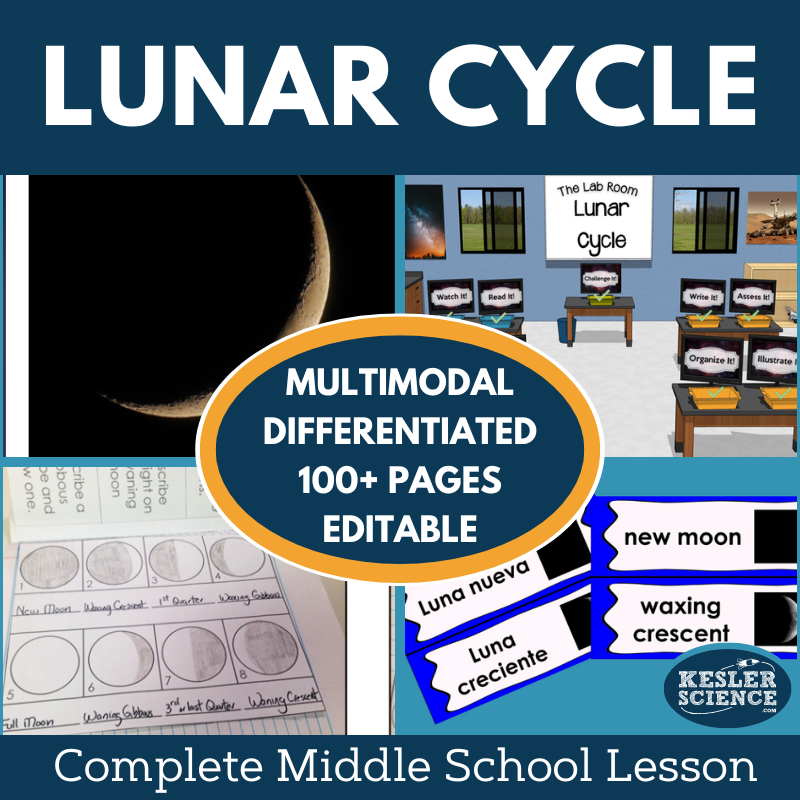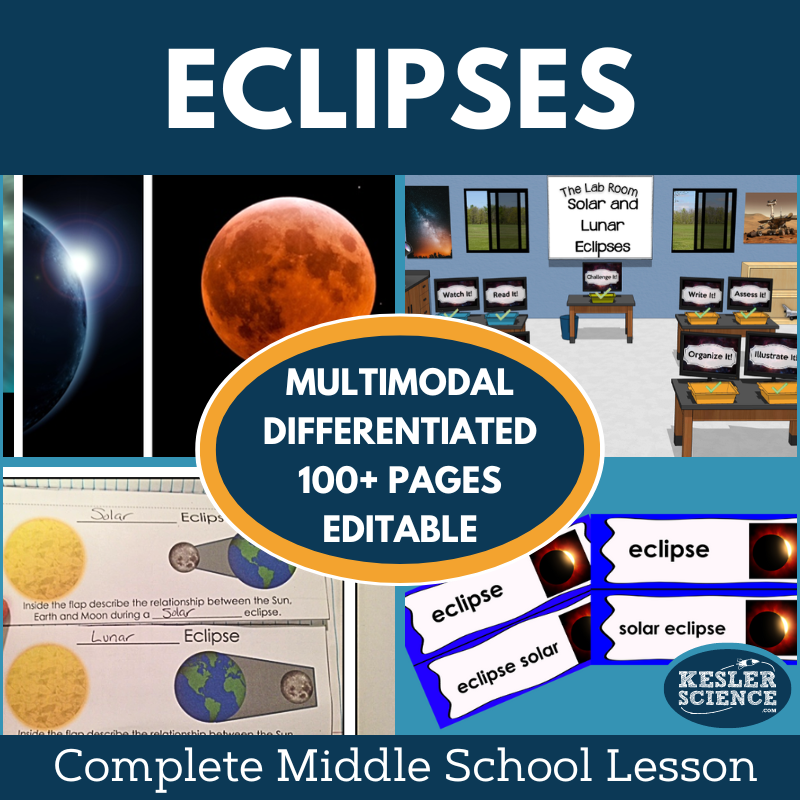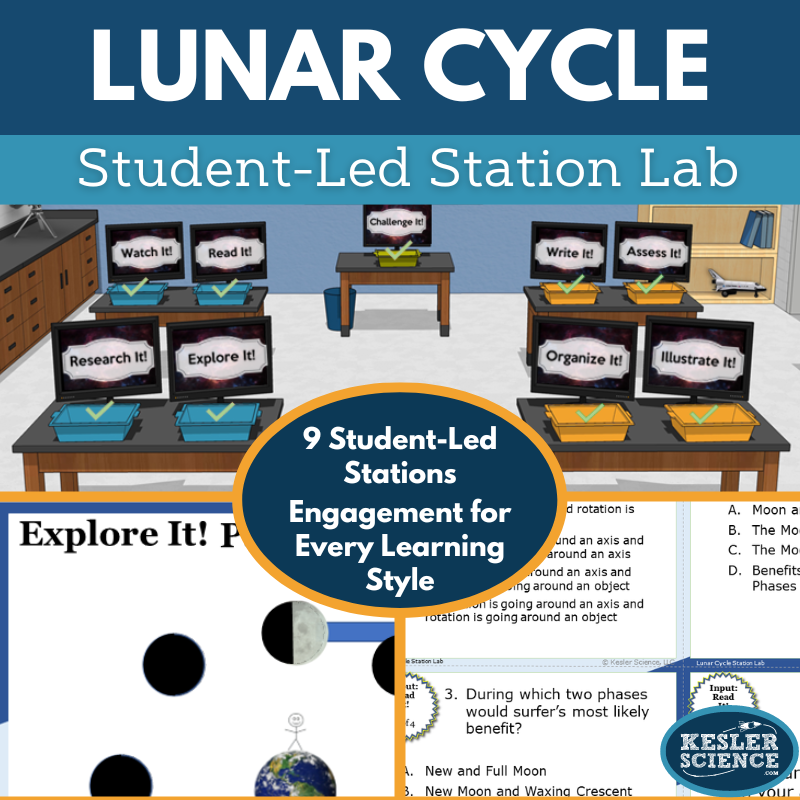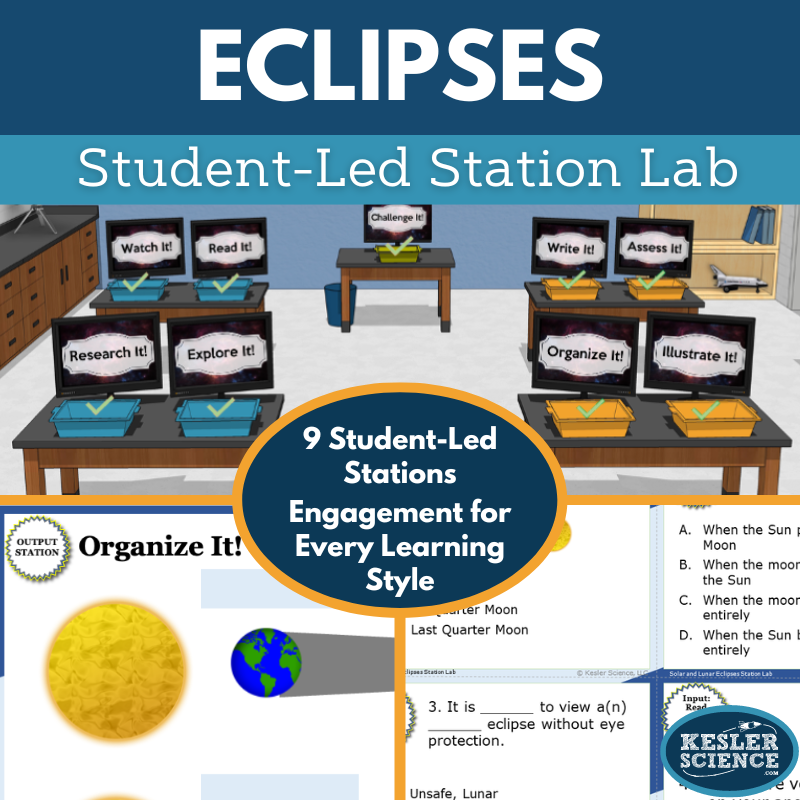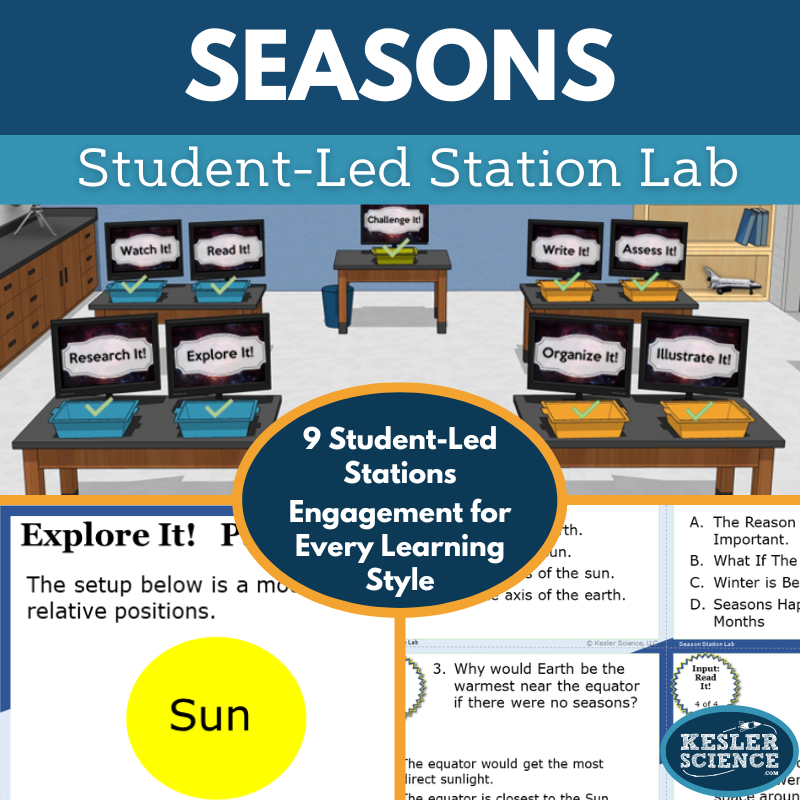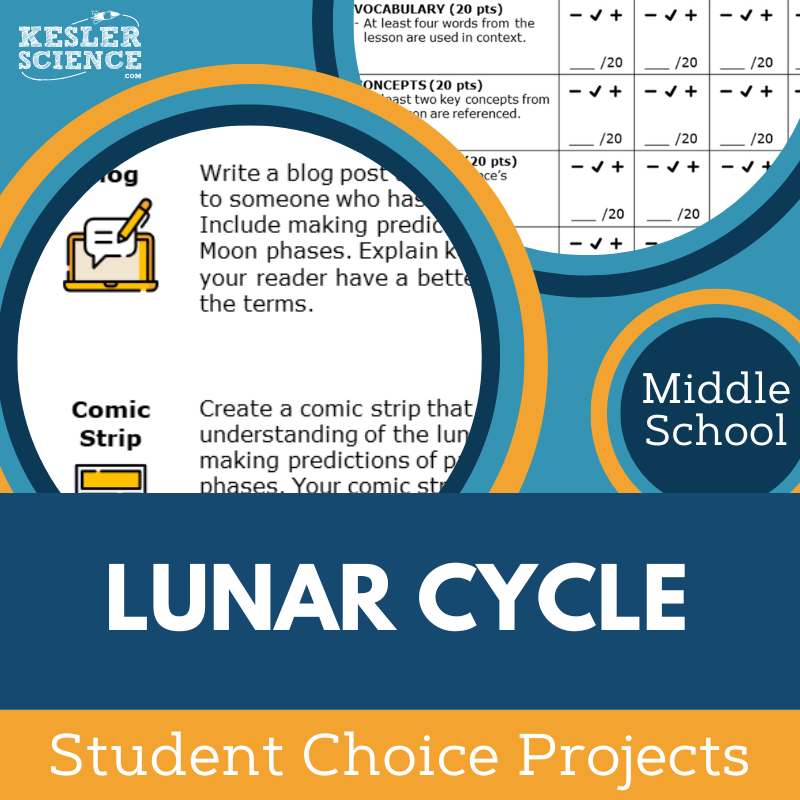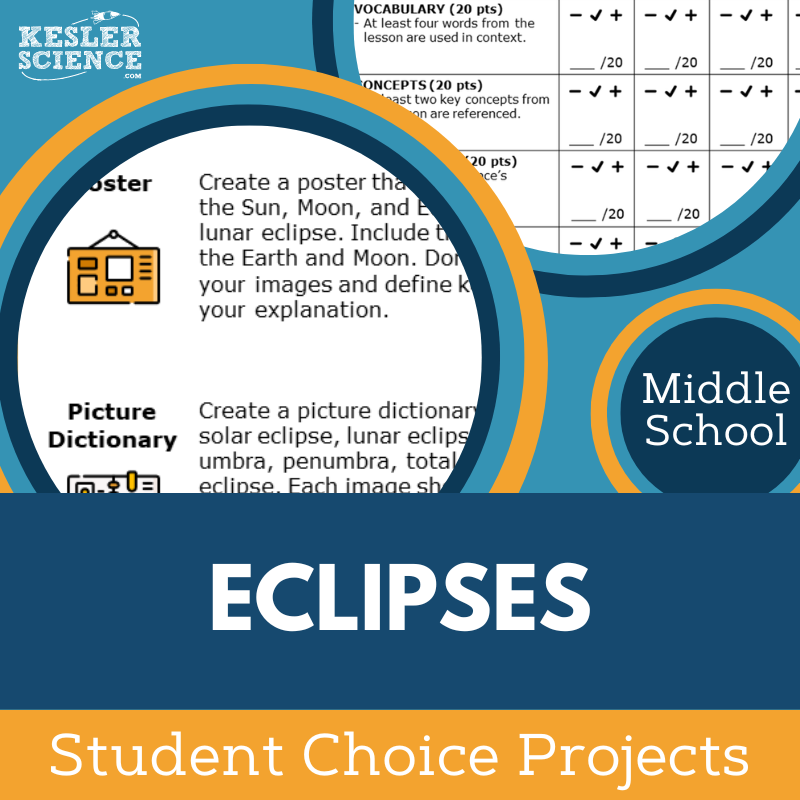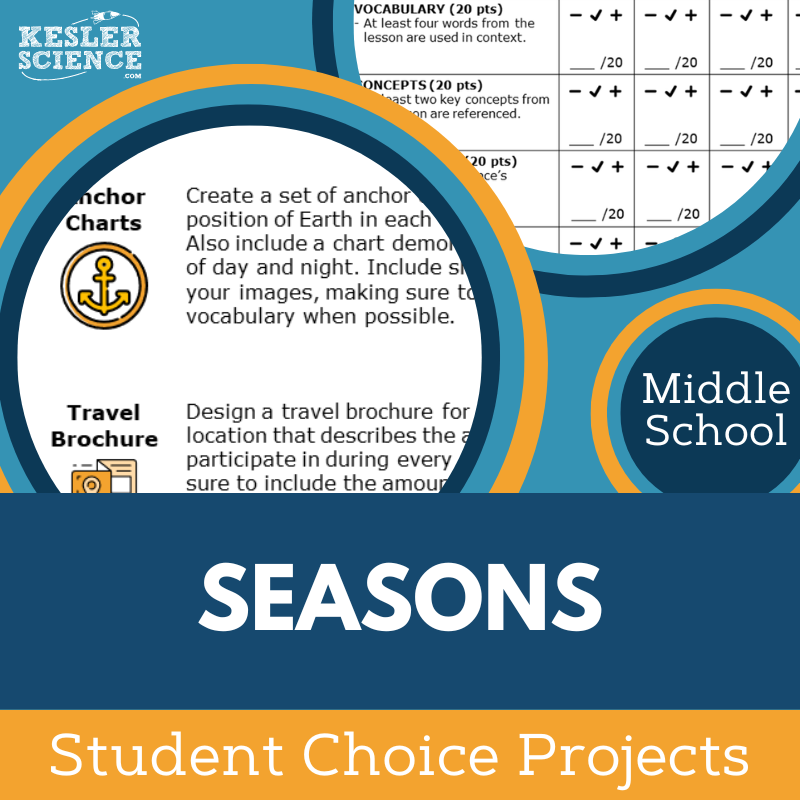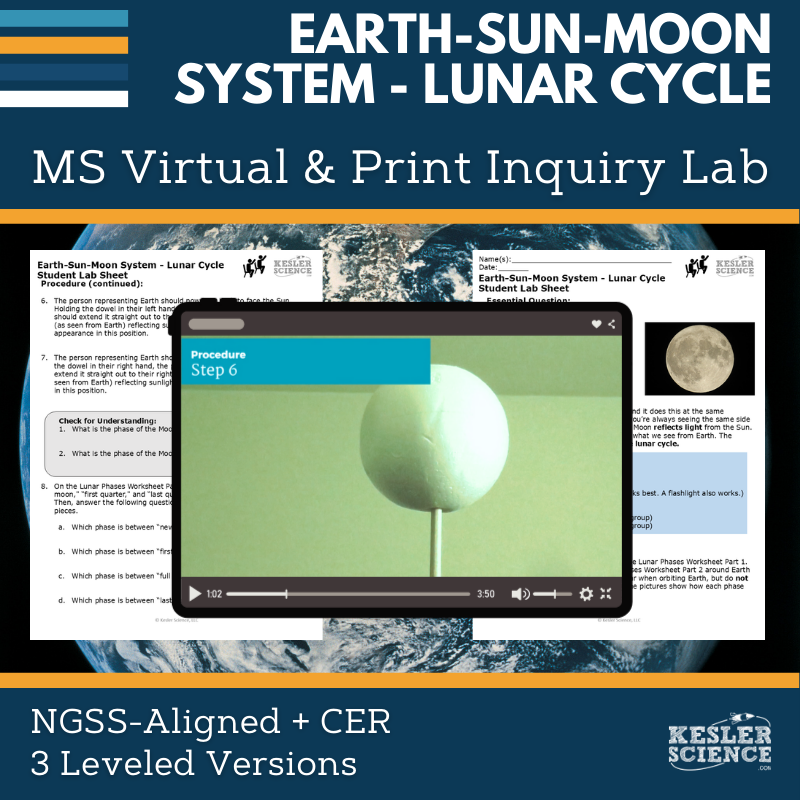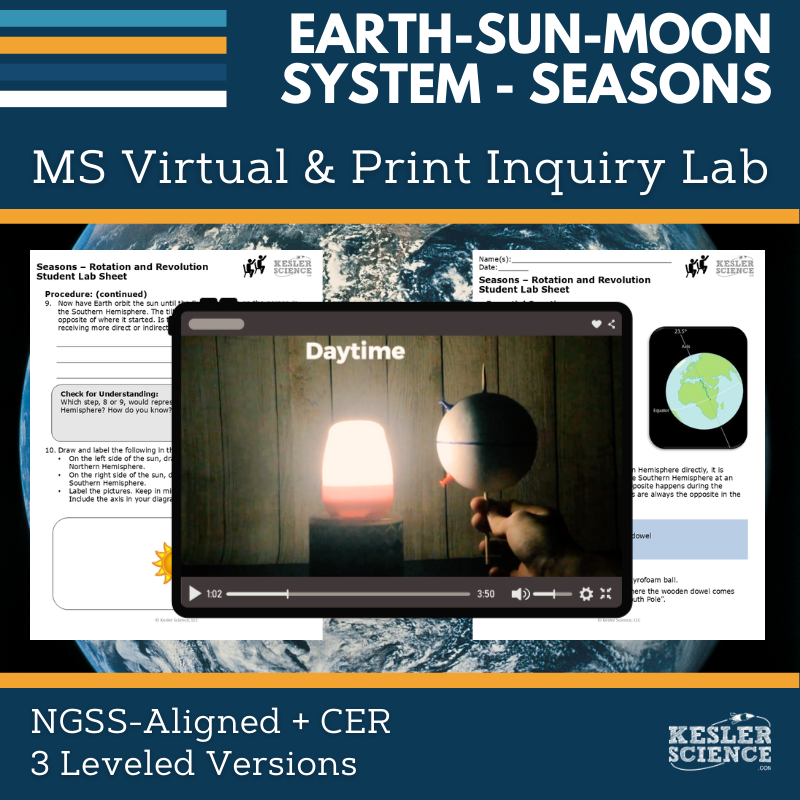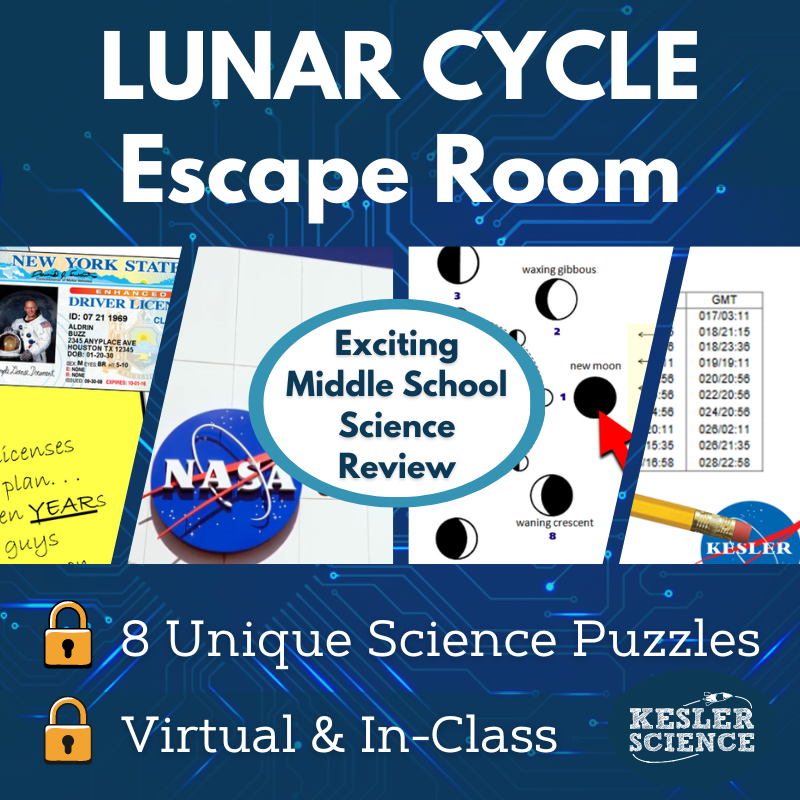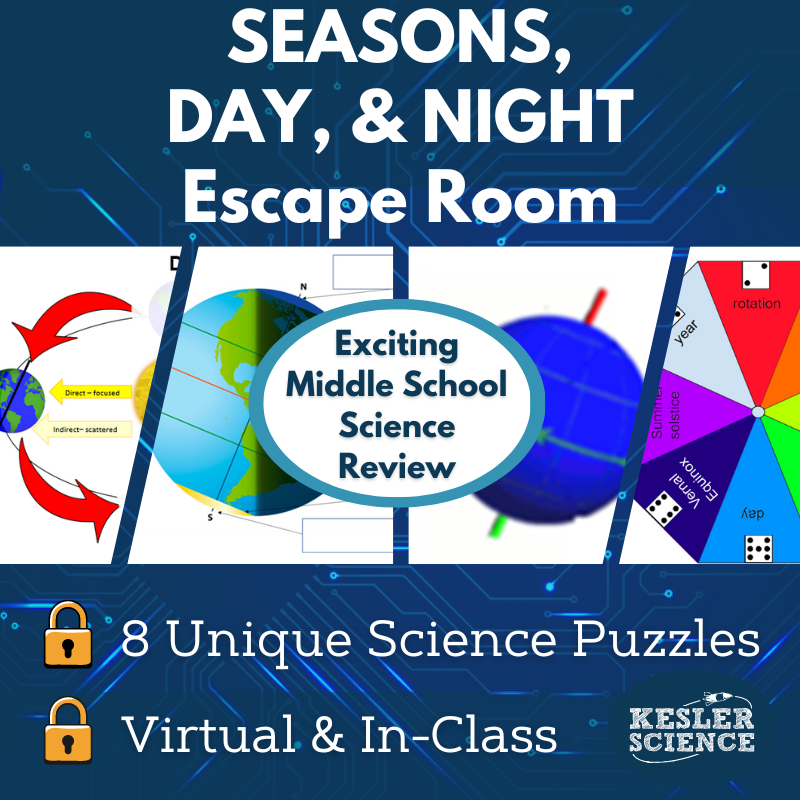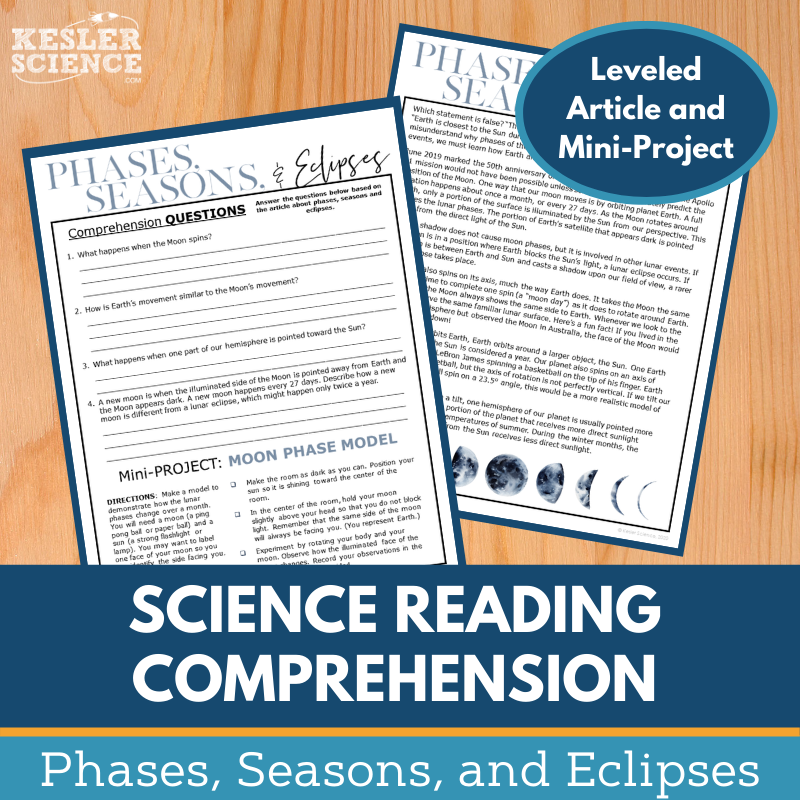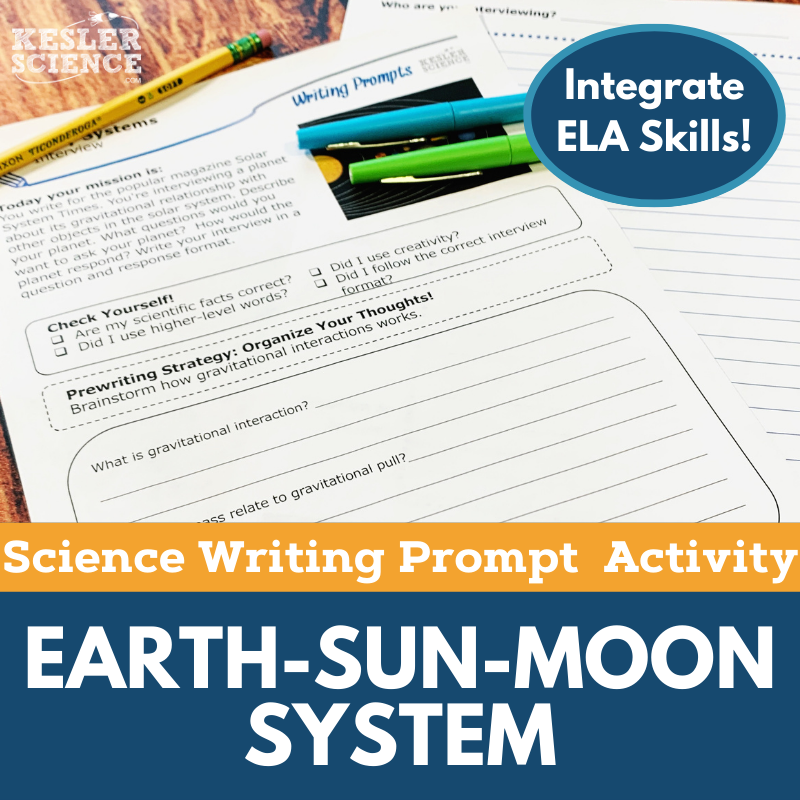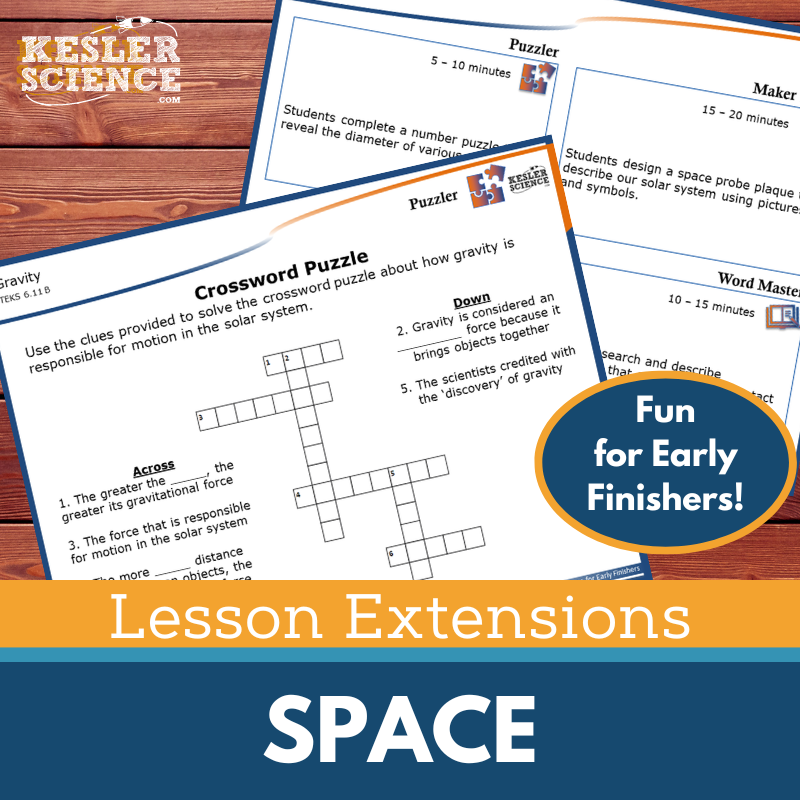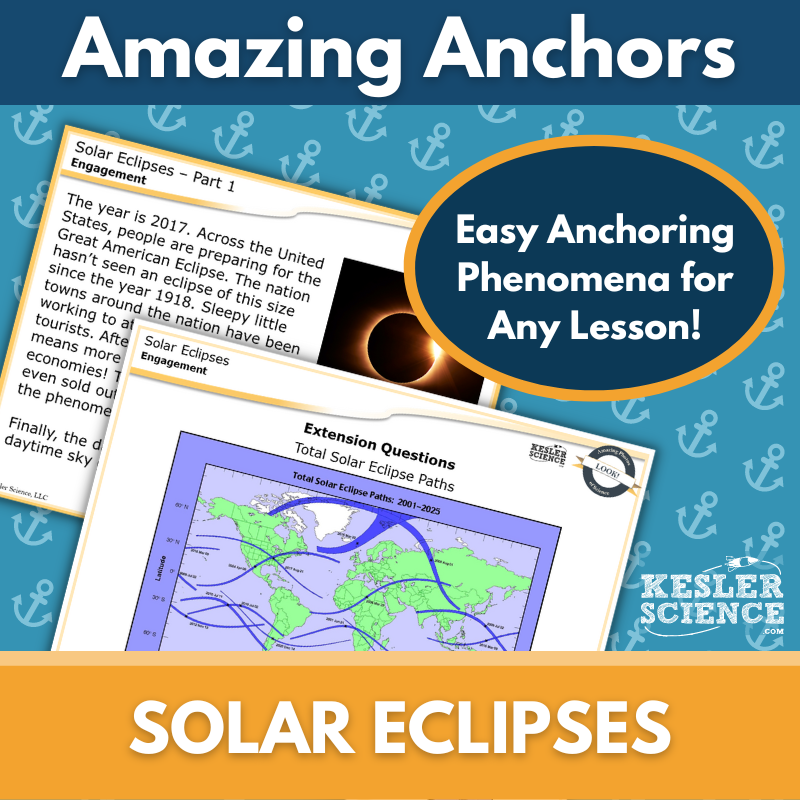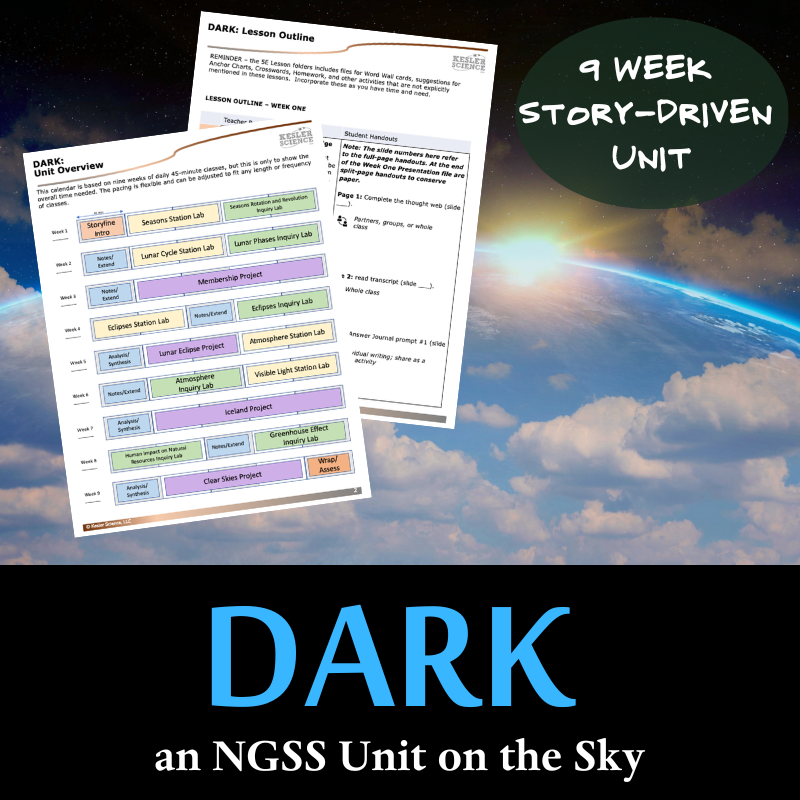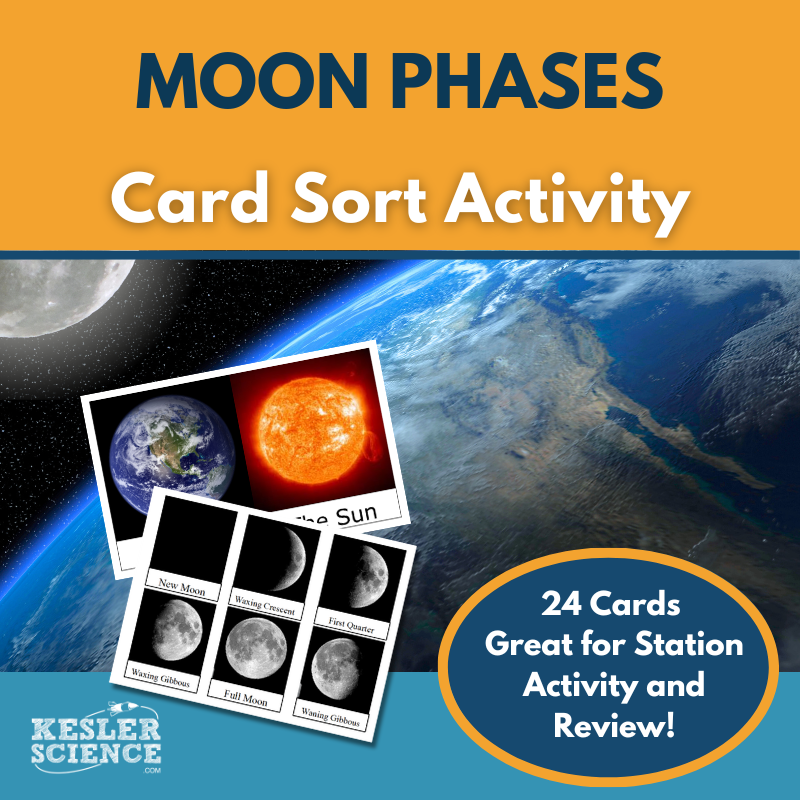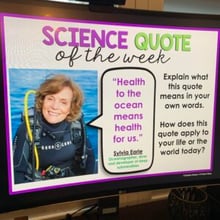Earth-Sun-Moon System Activities for Middle School Science
The Lunar Cycle, Eclipses, and Seasons 5E Lessons provide comprehensive, NGSS-aligned units that engage middle school students in understanding key astronomical concepts through student-led, multimodal learning. Available in both digital and print formats with Spanish translations, these lessons support flexible, in-class and virtual learning environments. The resources below will give students a comprehensive understanding of the Earth-Sun-Moon system. All of the following materials are also included in the Kesler Science Membership.
The Kesler Science Lunar Cycle 5E Lesson is a comprehensive unit designed to help middle school students understand and predict changes in the Moon’s appearance. It includes editable presentations, worksheets, choice projects, and assessments, all designed for student-led, differentiated learning. Aligned with NGSS standards, the lesson follows the 5E Model: Engagement, Exploration, Explanation, Elaboration, and Evaluation.
Students engage with essential questions through word wall vocabulary, teacher-led discussions, and interactive activities. The exploration phase features a student-led station lab with multimodal learning options, including hands-on experiments, reading passages in English and Spanish, research tasks, video discussions, and interactive assessments. Explanation includes editable PowerPoints, interactive notebook templates, and note-taking guides. Elaboration allows students to extend their understanding with choice projects on the lunar cycle, while evaluation includes updated STAAR 2.0 assessments, review questions, and worksheets for discussion or homework.
This resource is flexible for both in-person and virtual learning, with digital and printable options to suit different classroom needs. Spanish translations are available for vocabulary, reading passages, and interactive notebook pages.
The Kesler Science Lunar Cycle 5E Lesson is a comprehensive unit designed to help middle school students understand and predict changes in the Moon’s appearance. It includes editable presentations, worksheets, choice projects, and assessments, all designed for student-led, differentiated learning. Aligned with NGSS standards, the lesson follows the 5E Model: Engagement, Exploration, Explanation, Elaboration, and Evaluation.
Students engage with essential questions through word wall vocabulary, teacher-led discussions, and interactive activities. The exploration phase features a student-led station lab with multimodal learning options, including hands-on experiments, reading passages in English and Spanish, research tasks, video discussions, and interactive assessments. Explanation includes editable PowerPoints, interactive notebook templates, and note-taking guides. Elaboration allows students to extend their understanding with choice projects on the lunar cycle, while evaluation includes updated STAAR 2.0 assessments, review questions, and worksheets for discussion or homework.
This resource is flexible for both in-person and virtual learning, with digital and printable options to suit different classroom needs. Spanish translations are available for vocabulary, reading passages, and interactive notebook pages.
The Kesler Science Eclipses 5E Lesson is a comprehensive, student-led unit designed to engage middle school students in understanding solar and lunar eclipses. It includes editable presentations, worksheets, assessments, and student-choice projects, requiring minimal prep while supporting differentiated learning. The lesson is NGSS-aligned.
Students explore essential questions about how the positions of Earth, the Sun, and the Moon determine the type of eclipse and how shadows create partial and total eclipses. The unit follows the 5E Model, incorporating engagement activities, a hands-on exploration station lab with multimodal learning options, and interactive notebooks in English and Spanish. Explanation resources include editable PowerPoints, note-taking templates, and differentiated materials. Elaboration features student-choice projects, while evaluation includes STAAR 2.0-aligned assessments, review questions, and worksheets.
This flexible resource supports both printable and digital formats for in-class or virtual learning. With interactive and differentiated activities, Spanish translations, and various student engagement methods, this lesson ensures a comprehensive understanding of eclipses in an engaging and accessible way.
The Kesler Science Eclipses 5E Lesson is a comprehensive, student-led unit designed to engage middle school students in understanding solar and lunar eclipses. It includes editable presentations, worksheets, assessments, and student-choice projects, requiring minimal prep while supporting differentiated learning. The lesson is NGSS-aligned.
Students explore essential questions about how the positions of Earth, the Sun, and the Moon determine the type of eclipse and how shadows create partial and total eclipses. The unit follows the 5E Model, incorporating engagement activities, a hands-on exploration station lab with multimodal learning options, and interactive notebooks in English and Spanish. Explanation resources include editable PowerPoints, note-taking templates, and differentiated materials. Elaboration features student-choice projects, while evaluation includes STAAR 2.0-aligned assessments, review questions, and worksheets.
This flexible resource supports both printable and digital formats for in-class or virtual learning. With interactive and differentiated activities, Spanish translations, and various student engagement methods, this lesson ensures a comprehensive understanding of eclipses in an engaging and accessible way.
The Kesler Science Seasons 5E Lesson is a comprehensive middle school unit that includes presentations, worksheets, choice projects, and assessments. Designed for differentiated, student-led learning, it requires minimal prep and is fully editable. The lesson is NGSS aligned.
Following the 5E Model, the lesson engages students with objectives, word wall cards, and class discussion activities. The hands-on, student-led station lab in the Exploration phase includes nine stations offering multimodal learning through experiments, readings, videos, research, and interactive activities. Explanation features editable PowerPoints, interactive notebooks, and note-taking templates in English and Spanish. Elaboration includes student-choice projects, while Evaluation provides STAAR 2.0-aligned assessments and review worksheets.
With digital and printable options, Spanish translations, and flexible learning formats, this lesson supports both in-class and virtual learning.
The Kesler Science Seasons 5E Lesson is a comprehensive middle school unit that includes presentations, worksheets, choice projects, and assessments. Designed for differentiated, student-led learning, it requires minimal prep and is fully editable. The lesson is NGSS aligned.
Following the 5E Model, the lesson engages students with objectives, word wall cards, and class discussion activities. The hands-on, student-led station lab in the Exploration phase includes nine stations offering multimodal learning through experiments, readings, videos, research, and interactive activities. Explanation features editable PowerPoints, interactive notebooks, and note-taking templates in English and Spanish. Elaboration includes student-choice projects, while Evaluation provides STAAR 2.0-aligned assessments and review worksheets.
With digital and printable options, Spanish translations, and flexible learning formats, this lesson supports both in-class and virtual learning.
Engage your middle school students with this student-led Lunar Cycle Station Lab, designed to promote independent learning and critical thinking. This hands-on activity guides students as they demonstrate and predict the sequence of events in the lunar cycle through nine interactive stations.
Students explore new concepts using videos, readings, research, and hands-on demonstrations. They showcase their understanding through organizing information, illustrating models, writing responses, and completing assessments. A challenge station offers extension activities for advanced learners. Differentiated reading passages are available in English and Spanish to support varied learning needs.
This flexible resource can be used in both classroom and virtual settings, providing an engaging, multimodal approach to learning the lunar cycle.
Engage your middle school students with this student-led Lunar Cycle Station Lab, designed to promote independent learning and critical thinking. This hands-on activity guides students as they demonstrate and predict the sequence of events in the lunar cycle through nine interactive stations.
Students explore new concepts using videos, readings, research, and hands-on demonstrations. They showcase their understanding through organizing information, illustrating models, writing responses, and completing assessments. A challenge station offers extension activities for advanced learners. Differentiated reading passages are available in English and Spanish to support varied learning needs.
This flexible resource can be used in both classroom and virtual settings, providing an engaging, multimodal approach to learning the lunar cycle.
Engage your students with this student-led station lab on eclipses, designed to promote independent learning while minimizing teacher prep time. Through interactive stations, students develop and use a model of the Earth-Sun-Moon system to describe cyclic patterns.
This activity features nine differentiated stations, offering hands-on exploration, research, reading, videos, and creative outputs. Students organize information, illustrate models, respond to prompts, and complete assessments, with an optional challenge station for extension activities. Stations include a mix of physical and digital tasks, with Spanish and English reading passages for differentiated support.
Ideal for in-class or virtual learning, this resource fosters engagement, critical thinking, and active exploration of space science concepts.
Engage your students with this student-led station lab on eclipses, designed to promote independent learning while minimizing teacher prep time. Through interactive stations, students develop and use a model of the Earth-Sun-Moon system to describe cyclic patterns.
This activity features nine differentiated stations, offering hands-on exploration, research, reading, videos, and creative outputs. Students organize information, illustrate models, respond to prompts, and complete assessments, with an optional challenge station for extension activities. Stations include a mix of physical and digital tasks, with Spanish and English reading passages for differentiated support.
Ideal for in-class or virtual learning, this resource fosters engagement, critical thinking, and active exploration of space science concepts.
Engage your middle school students with this student-led Seasons Station Lab, designed to model and illustrate how Earth's axial tilt and orbit around the Sun create seasonal changes. This interactive lesson allows students to direct their own learning while teachers facilitate.
Featuring nine differentiated stations, students explore the seasons through hands-on demonstrations, research, readings, videos, and creative tasks. Input stations introduce concepts through experiments, multimedia, and text, while output stations encourage students to organize, illustrate, write, and assess their understanding. A bonus challenge station offers extension activities for advanced learners.
With both physical and digital versions available, this resource supports in-class and virtual learning, making it a flexible and engaging way to deepen students' understanding of the seasons.
Engage your middle school students with this student-led Seasons Station Lab, designed to model and illustrate how Earth's axial tilt and orbit around the Sun create seasonal changes. This interactive lesson allows students to direct their own learning while teachers facilitate.
Featuring nine differentiated stations, students explore the seasons through hands-on demonstrations, research, readings, videos, and creative tasks. Input stations introduce concepts through experiments, multimedia, and text, while output stations encourage students to organize, illustrate, write, and assess their understanding. A bonus challenge station offers extension activities for advanced learners.
With both physical and digital versions available, this resource supports in-class and virtual learning, making it a flexible and engaging way to deepen students' understanding of the seasons.
The Lunar Cycle Student Choice Projects lesson allows middle school students to demonstrate their understanding through a project that fits their preferred output style. A project page outlines six student-led options plus a “design your own” project, all supported by an editable rubric for teacher, peer, or self-assessment.
These flexible projects offer creative, multimodal ways for students to engage with the material. Two versions of the project page support differentiation, with modified options for students needing remediation and challenge opportunities for advanced learners. Teachers can customize the rubric to fit grading needs.
The projects require standard classroom supplies like paper, markers, and scissors, with many options available for digital completion. Some crafting materials may be useful for model-building activities.
The Lunar Cycle Student Choice Projects lesson allows middle school students to demonstrate their understanding through a project that fits their preferred output style. A project page outlines six student-led options plus a “design your own” project, all supported by an editable rubric for teacher, peer, or self-assessment.
These flexible projects offer creative, multimodal ways for students to engage with the material. Two versions of the project page support differentiation, with modified options for students needing remediation and challenge opportunities for advanced learners. Teachers can customize the rubric to fit grading needs.
The projects require standard classroom supplies like paper, markers, and scissors, with many options available for digital completion. Some crafting materials may be useful for model-building activities.
The Eclipses Student Choice Projects lesson allows middle school students to select a project that fits their preferred output style. A project page outlines six student-led options plus a “design your own” project, with an editable rubric for teacher, peer, or self-assessment.
These flexible, multimodal projects offer creative ways for students to demonstrate their understanding. Two versions of the project page support differentiation, with modified options for students needing remediation and challenge opportunities for advanced learners. Teachers can adjust the rubric to fit grading needs.
The projects use common classroom supplies like paper, markers, and scissors, with many options available for digital completion.
The Eclipses Student Choice Projects lesson allows middle school students to select a project that fits their preferred output style. A project page outlines six student-led options plus a “design your own” project, with an editable rubric for teacher, peer, or self-assessment.
These flexible, multimodal projects offer creative ways for students to demonstrate their understanding. Two versions of the project page support differentiation, with modified options for students needing remediation and challenge opportunities for advanced learners. Teachers can adjust the rubric to fit grading needs.
The projects use common classroom supplies like paper, markers, and scissors, with many options available for digital completion.
The Seasons Student Choice Projects lesson allows middle school students to select a project that matches their preferred output style. A project page outlines six student-led options plus a “design your own” project, all supported by a grading rubric for teacher, peer, or self-assessment.
These flexible, multimodal projects offer creative ways for students to demonstrate their understanding. Teachers can modify the rubric to fit grading needs, and two versions of the project page provide differentiation—one with targeted support for students needing remediation and another allowing advanced students to combine projects for a challenge.
The projects require standard classroom supplies such as paper, markers, and scissors, with many options available for digital completion. Some crafting materials may be useful for building models.
The Seasons Student Choice Projects lesson allows middle school students to select a project that matches their preferred output style. A project page outlines six student-led options plus a “design your own” project, all supported by a grading rubric for teacher, peer, or self-assessment.
These flexible, multimodal projects offer creative ways for students to demonstrate their understanding. Teachers can modify the rubric to fit grading needs, and two versions of the project page provide differentiation—one with targeted support for students needing remediation and another allowing advanced students to combine projects for a challenge.
The projects require standard classroom supplies such as paper, markers, and scissors, with many options available for digital completion. Some crafting materials may be useful for building models.
The Lunar Cycle Inquiry Lab aligns with NGSS MS-ESS1-1, guiding students to create a model that demonstrates and describes lunar phases. This lab offers both a hands-on printed experiment and an interactive virtual demonstration with a pre-recorded video. Each version includes comprehension questions, Claim-Evidence-Reasoning (C.E.R.) prompts, and a reflection section.
Designed for differentiation, the lab is available at three levels: dependent (guided instructions with inquiry questions), modified (structured with sentence stems and multiple-choice options), and independent (student-led with minimal guidance). The print version provides a traditional hands-on experience, requiring materials such as a Styrofoam ball, light source, and wooden dowel. The digital version, compatible with Google Slides and other platforms, features an interactive PowerPoint with built-in virtual activities, eliminating the need for materials.
Editable teacher resources include answer keys, standards alignment, prep guides, and reflection questions. With flexible print and digital options, this lab engages students through multimodal learning while allowing teachers to tailor instruction to their classroom needs.
The Lunar Cycle Inquiry Lab aligns with NGSS MS-ESS1-1, guiding students to create a model that demonstrates and describes lunar phases. This lab offers both a hands-on printed experiment and an interactive virtual demonstration with a pre-recorded video. Each version includes comprehension questions, Claim-Evidence-Reasoning (C.E.R.) prompts, and a reflection section.
Designed for differentiation, the lab is available at three levels: dependent (guided instructions with inquiry questions), modified (structured with sentence stems and multiple-choice options), and independent (student-led with minimal guidance). The print version provides a traditional hands-on experience, requiring materials such as a Styrofoam ball, light source, and wooden dowel. The digital version, compatible with Google Slides and other platforms, features an interactive PowerPoint with built-in virtual activities, eliminating the need for materials.
Editable teacher resources include answer keys, standards alignment, prep guides, and reflection questions. With flexible print and digital options, this lab engages students through multimodal learning while allowing teachers to tailor instruction to their classroom needs.
The Eclipses Inquiry Lab aligns with NGSS MS-ESS1-1, guiding students to develop a model of the Earth-Sun-Moon system to describe solar and lunar eclipses. This resource offers both a hands-on print experiment and an interactive digital version, complete with a pre-recorded video demonstration.
Students engage with comprehension questions, Claim-Evidence-Reasoning (C.E.R.) prompts, and reflection sections. The lab includes three differentiated levels: Dependent for on-level learners with guided inquiry, Modified for structured support with simplified questioning, and Independent for advanced students who take a self-directed approach.
The print version involves constructing a model using wooden dowels, clay, a meter stick, binder clips, and a flashlight. The digital format, compatible with Google Slides and learning management systems, requires no materials and features virtual activities and a step-by-step lab procedure video.
This flexible lab includes editable PowerPoints, teacher resource pages with standards and objectives, answer keys, and multimodal learning strategies to engage students.
The Eclipses Inquiry Lab aligns with NGSS MS-ESS1-1, guiding students to develop a model of the Earth-Sun-Moon system to describe solar and lunar eclipses. This resource offers both a hands-on print experiment and an interactive digital version, complete with a pre-recorded video demonstration.
Students engage with comprehension questions, Claim-Evidence-Reasoning (C.E.R.) prompts, and reflection sections. The lab includes three differentiated levels: Dependent for on-level learners with guided inquiry, Modified for structured support with simplified questioning, and Independent for advanced students who take a self-directed approach.
The print version involves constructing a model using wooden dowels, clay, a meter stick, binder clips, and a flashlight. The digital format, compatible with Google Slides and learning management systems, requires no materials and features virtual activities and a step-by-step lab procedure video.
This flexible lab includes editable PowerPoints, teacher resource pages with standards and objectives, answer keys, and multimodal learning strategies to engage students.
The Seasons Inquiry Lab aligns with NGSS MS-ESS1-1, helping students develop a model to explain Earth's seasonal changes. This lab includes both a virtual demonstration with a pre-recorded video and a hands-on printed experiment, both featuring comprehension questions, Claim-Evidence-Reasoning (C.E.R.) prompts, and a reflection section.
Designed for differentiation, the lab offers three versions: Dependent (guided inquiry), Modified (structured with additional support), and Independent (student-led exploration). The print format includes hands-on procedures using a Styrofoam ball, flashlight, push pins, wooden dowel, and markers. The digital format is an interactive PowerPoint compatible with Google Slides and major LMS platforms, featuring a video walkthrough of the lab.
Teachers benefit from editable resources, teacher guides, answer keys, and flexible formats to support diverse learning needs. Whether using the print or digital version, this engaging lab provides an interactive way for students to explore Earth's seasonal changes.
The Seasons Inquiry Lab aligns with NGSS MS-ESS1-1, helping students develop a model to explain Earth's seasonal changes. This lab includes both a virtual demonstration with a pre-recorded video and a hands-on printed experiment, both featuring comprehension questions, Claim-Evidence-Reasoning (C.E.R.) prompts, and a reflection section.
Designed for differentiation, the lab offers three versions: Dependent (guided inquiry), Modified (structured with additional support), and Independent (student-led exploration). The print format includes hands-on procedures using a Styrofoam ball, flashlight, push pins, wooden dowel, and markers. The digital format is an interactive PowerPoint compatible with Google Slides and major LMS platforms, featuring a video walkthrough of the lab.
Teachers benefit from editable resources, teacher guides, answer keys, and flexible formats to support diverse learning needs. Whether using the print or digital version, this engaging lab provides an interactive way for students to explore Earth's seasonal changes.
The Lunar Cycle Escape Room is an engaging activity that challenges students to demonstrate their understanding of the lunar cycle by predicting past and future moon phases. To succeed, students should be familiar with the phases of the Moon, their sequence, and the approximate time it takes for one phase to transition to the next.
Teachers have full control over the experience, choosing from eight independent puzzles that can be used in any order to fit class time constraints. The escape room can be conducted using simple manila envelopes or a more immersive setup with locks and a storage box. Materials needed include printed resources, envelopes, and a reflective surface such as a small mirror or a phone camera.
A digital version is available for online learning, with a Single Student Digital Version in PowerPoint that can be shared through email or a learning management system. This version is also compatible with Google Slides. A printable version in PPT or PDF is provided for at-home use.
Included in this resource are teacher directions, a detailed answer key, an editable teacher version, a digital answer sheet (Google Form), a video challenge, and eight unique puzzles with printable props. Additional features include reward templates, over 50 prize ideas, and 30 editable signs for post-activity photos. This exciting and immersive escape room will leave students talking about their experience for weeks!
The Lunar Cycle Escape Room is an engaging activity that challenges students to demonstrate their understanding of the lunar cycle by predicting past and future moon phases. To succeed, students should be familiar with the phases of the Moon, their sequence, and the approximate time it takes for one phase to transition to the next.
Teachers have full control over the experience, choosing from eight independent puzzles that can be used in any order to fit class time constraints. The escape room can be conducted using simple manila envelopes or a more immersive setup with locks and a storage box. Materials needed include printed resources, envelopes, and a reflective surface such as a small mirror or a phone camera.
A digital version is available for online learning, with a Single Student Digital Version in PowerPoint that can be shared through email or a learning management system. This version is also compatible with Google Slides. A printable version in PPT or PDF is provided for at-home use.
Included in this resource are teacher directions, a detailed answer key, an editable teacher version, a digital answer sheet (Google Form), a video challenge, and eight unique puzzles with printable props. Additional features include reward templates, over 50 prize ideas, and 30 editable signs for post-activity photos. This exciting and immersive escape room will leave students talking about their experience for weeks!
The Seasons, Day & Night Escape Room is an interactive activity that allows students to demonstrate their understanding of Earth's rotation, revolution, seasons, and the day-and-night cycle in an engaging way. Aligned with NGSS MS-ESS1-1, this experience challenges students to model and illustrate how Earth's tilt and movement around the Sun influence seasonal changes.
Teachers have full control over the eight independent puzzles, allowing flexibility in selection and order based on class time. The escape room can be conducted using manila envelopes for a simple setup or enhanced with locks, a storage box, and UV pens for a more immersive experience.
A digital version is available for online learning via PowerPoint or Google Slides, allowing students to solve puzzles by answering questions and manipulating images. A printable version in PPT and PDF formats is also provided for at-home use, with restrictions on public sharing.
Included in this resource are teacher directions, a detailed answer key, a digital answer sheet, an editable teacher version, and a video challenge to set the scene. Students will engage with eight unique puzzles, printable props, reward templates, and over 50 prize ideas. With fun, interactive elements and customizable features, this escape room will keep students engaged long after the challenge ends.
The Seasons, Day & Night Escape Room is an interactive activity that allows students to demonstrate their understanding of Earth's rotation, revolution, seasons, and the day-and-night cycle in an engaging way. Aligned with NGSS MS-ESS1-1, this experience challenges students to model and illustrate how Earth's tilt and movement around the Sun influence seasonal changes.
Teachers have full control over the eight independent puzzles, allowing flexibility in selection and order based on class time. The escape room can be conducted using manila envelopes for a simple setup or enhanced with locks, a storage box, and UV pens for a more immersive experience.
A digital version is available for online learning via PowerPoint or Google Slides, allowing students to solve puzzles by answering questions and manipulating images. A printable version in PPT and PDF formats is also provided for at-home use, with restrictions on public sharing.
Included in this resource are teacher directions, a detailed answer key, a digital answer sheet, an editable teacher version, and a video challenge to set the scene. Students will engage with eight unique puzzles, printable props, reward templates, and over 50 prize ideas. With fun, interactive elements and customizable features, this escape room will keep students engaged long after the challenge ends.
This Phases, Seasons, and Eclipses Science Reading Comprehension Lesson helps students explore how Earth and the Moon move in relation to the Sun. Designed for middle school, the leveled passage supports science literacy and reading comprehension.
The resource includes two Lexile-leveled articles (1100-1300), five to seven comprehension questions, a hands-on moon phase model, and a Cornell notes template. It features engaging, printable graphics and is compatible with Google Classroom, MS Teams, Schoology, and Canvas for virtual learning.
Perfect for sub plans, ISS, extra credit, or whole-class instruction, this resource fosters critical thinking, classroom discussions, and textual analysis while reinforcing key science concepts.
This Phases, Seasons, and Eclipses Science Reading Comprehension Lesson helps students explore how Earth and the Moon move in relation to the Sun. Designed for middle school, the leveled passage supports science literacy and reading comprehension.
The resource includes two Lexile-leveled articles (1100-1300), five to seven comprehension questions, a hands-on moon phase model, and a Cornell notes template. It features engaging, printable graphics and is compatible with Google Classroom, MS Teams, Schoology, and Canvas for virtual learning.
Perfect for sub plans, ISS, extra credit, or whole-class instruction, this resource fosters critical thinking, classroom discussions, and textual analysis while reinforcing key science concepts.
The Earth-Sun-Moon System Writing Prompt Activity engages middle school students in a creative letter-writing exercise to reinforce their understanding of Earth science. Aligned with NGSS MS-ESS1-1, this activity supports science reasoning and exploration while allowing for virtual learning.
This resource includes teacher directions with an answer guide, project ideas, and rubrics; projection and print handouts in full-size and half-sheet formats; and a digital PowerPoint version adaptable for Google Slides. The activity works well as a cross-curricular task, pre-test assessment, student choice project, or enrichment for early finishers. It can also be used for extra credit, make-up work, TELPAS samples, or differentiation. Ideal for in-person and remote learners, this writing prompt fosters engagement, creativity, and science literacy in any classroom.
The Earth-Sun-Moon System Writing Prompt Activity engages middle school students in a creative letter-writing exercise to reinforce their understanding of Earth science. Aligned with NGSS MS-ESS1-1, this activity supports science reasoning and exploration while allowing for virtual learning.
This resource includes teacher directions with an answer guide, project ideas, and rubrics; projection and print handouts in full-size and half-sheet formats; and a digital PowerPoint version adaptable for Google Slides. The activity works well as a cross-curricular task, pre-test assessment, student choice project, or enrichment for early finishers. It can also be used for extra credit, make-up work, TELPAS samples, or differentiation. Ideal for in-person and remote learners, this writing prompt fosters engagement, creativity, and science literacy in any classroom.
Lesson Extensions provide engaging, student-choice activities designed to challenge early finishers and deepen their understanding of space science standards. These activities encourage critical thinking, creativity, and hands-on learning, making them perfect for lesson wrap-ups, independent challenges, and filling downtime with meaningful engagement.
Each extension includes four interactive components: Puzzler for problem-solving, Maker Space for hands-on STEAM activities, Tech Connection for digital demonstrations, and Word Master for creative writing. With teacher directions, answer keys, and both print and projection versions, these extensions offer high-level, rigorous opportunities to explore space science concepts.
Students will investigate topics such as the components of the universe, Earth-Moon-Sun relationships, gravity, space travel, the lunar cycle, the origin of the universe, solar system properties, and more. Aligned with NGSS and TEKS standards, these extensions ensure that students remain engaged while expanding their scientific knowledge.
Lesson Extensions provide engaging, student-choice activities designed to challenge early finishers and deepen their understanding of space science standards. These activities encourage critical thinking, creativity, and hands-on learning, making them perfect for lesson wrap-ups, independent challenges, and filling downtime with meaningful engagement.
Each extension includes four interactive components: Puzzler for problem-solving, Maker Space for hands-on STEAM activities, Tech Connection for digital demonstrations, and Word Master for creative writing. With teacher directions, answer keys, and both print and projection versions, these extensions offer high-level, rigorous opportunities to explore space science concepts.
Students will investigate topics such as the components of the universe, Earth-Moon-Sun relationships, gravity, space travel, the lunar cycle, the origin of the universe, solar system properties, and more. Aligned with NGSS and TEKS standards, these extensions ensure that students remain engaged while expanding their scientific knowledge.
This Amazing Anchors Phenomenon Lesson introduces and reinforces solar eclipses through real-world connections. It includes an introductory reading on the 2017 solar eclipse with comprehension and extension questions to prepare students for deeper learning, followed by an explanatory reading that breaks down the science behind solar eclipses with additional reinforcement questions.
Aligned with NGSS Standard MS ESS1-1, this no-prep resource includes teacher directions, answer keys, projection slides, and both print and digital formats for Google Classroom and other LMS platforms. A differentiated version provides sentence starters to support student comprehension. Designed to bookend a lesson, these engaging readings serve as effective supplements for the Engagement and Elaborate segments of 5E lessons in any in-person or virtual classroom.
This Amazing Anchors Phenomenon Lesson introduces and reinforces solar eclipses through real-world connections. It includes an introductory reading on the 2017 solar eclipse with comprehension and extension questions to prepare students for deeper learning, followed by an explanatory reading that breaks down the science behind solar eclipses with additional reinforcement questions.
Aligned with NGSS Standard MS ESS1-1, this no-prep resource includes teacher directions, answer keys, projection slides, and both print and digital formats for Google Classroom and other LMS platforms. A differentiated version provides sentence starters to support student comprehension. Designed to bookend a lesson, these engaging readings serve as effective supplements for the Engagement and Elaborate segments of 5E lessons in any in-person or virtual classroom.
"Explories: DARK” is an NGSS unit that immerses students in a real-world storyline, integrating Kesler Science inquiry labs, station labs, and 5E lessons. Students join the fictitious Amateur Astronomers’ Conservation Society, where they explore the relationships between Earth, the Sun, and the Moon and evaluate atmospheric changes that could impact our future.
This unit includes a structured curriculum with a unit overview, day-by-day teacher instructions, four unit projects, student activity pages, journaling and synthesis activities, and both project-based and traditional assessments. It features five station labs, six inquiry labs, and five 5E lessons, along with rubrics for feedback and standards-based grading. Teachers also receive two training videos to guide implementation.
Aligned with NGSS standards MS-ESS3-4 and MS-ESS3-5, this unit encourages students to construct evidence-based arguments on human impact on Earth's systems and investigate the factors driving global temperature rise. Through hands-on labs and engaging lessons, students gain a deeper understanding of the sky and its significance.
"Explories: DARK” is an NGSS unit that immerses students in a real-world storyline, integrating Kesler Science inquiry labs, station labs, and 5E lessons. Students join the fictitious Amateur Astronomers’ Conservation Society, where they explore the relationships between Earth, the Sun, and the Moon and evaluate atmospheric changes that could impact our future.
This unit includes a structured curriculum with a unit overview, day-by-day teacher instructions, four unit projects, student activity pages, journaling and synthesis activities, and both project-based and traditional assessments. It features five station labs, six inquiry labs, and five 5E lessons, along with rubrics for feedback and standards-based grading. Teachers also receive two training videos to guide implementation.
Aligned with NGSS standards MS-ESS3-4 and MS-ESS3-5, this unit encourages students to construct evidence-based arguments on human impact on Earth's systems and investigate the factors driving global temperature rise. Through hands-on labs and engaging lessons, students gain a deeper understanding of the sky and its significance.
The Moon Phases card sort activity is a versatile tool for teaching moon phases. Students will use photo cards to identify and place moon phases in relation to Earth and the Sun. The set includes labeled and blank photo cards for the moon phases, as well as labeled and blank cards for Earth and the Sun.
Students can engage in multiple activities, such as matching moon phase names to images or arranging them correctly in relation to Earth and the Sun. The activity reinforces learning in the classroom and can also be used for interventions or state test prep.
The Moon Phases card sort activity is a versatile tool for teaching moon phases. Students will use photo cards to identify and place moon phases in relation to Earth and the Sun. The set includes labeled and blank photo cards for the moon phases, as well as labeled and blank cards for the Sun and Earth.
Students can engage in multiple activities, such as matching moon phase names to images or arranging them correctly in relation to Earth and the Sun. The activity reinforces learning in the classroom and can also be used for interventions or state test prep.
Year-Round Resources
These year-round activities will increase your students' understanding of many middle school science topics. All of these activities are also included in the Kesler Science Membership.
Visual Data & Graphing
You're not alone if your students struggle with understanding graphs, charts, and tables. It's a skill that takes an enormous amount of practice. This resource will help students build a strong foundation in analyzing data and creating their own data visualizations.
Bell Ringers and Warm-Ups
These middle school science bell ringers are an excellent way to engage your students as soon as they walk into your classroom. This comprehensive FULL YEAR resource includes everything you need to start off each science class with an interesting warm-up activity.
Review Board Games
Each game board has been carefully designed to keep students engaged. There are 10 different action spaces on each board and dozens of question cards. All of the actions are related to science concepts and keep the students motivated throughout the game.
Each game is ready to play. Simply print out the board and the cards and let the students enjoy reviewing nine different units.
Essential Questions and Standards
Below are the essential questions and standards associated with the lessons and activities included in the Earth-Sun-Moon unit. This topic is only one of more than 100 middle school science topics included in the Kesler Science Membership.
-
Why does the moon look different every night?
-
Can you make predictions about the Moon’s appearance?
-
Can you describe how the positions of the Sun, Moon and Earth determine the type of eclipse?
-
Can you model how the shadow cast in an eclipse causes partial and total eclipses?
-
What causes day and night?
-
What causes the seasons to change?
-
NGSS - MS-ESS1-1 Earth-Sun-Moon System
Kesler Science Membership
Imagine never having to search for another middle school science lesson again. The membership gives you access to ALL of the Kesler Science products in one place (Yes, including everything above).
Say goodbye to long hours of lesson prep.

